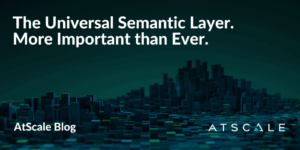June 29, 2020
The 1990’s Called, They Want Their OLAP Back
You are probably familiar with the concept of a semantic layer. According to Wikipedia, “a semantic layer is a business representation of corporate data that helps end users access data autonomously using common business terms. A semantic layer maps complex data into familiar business terms such as product, customer, or revenue to offer a unified, consolidated view of data across the organization.” But are you familiar with a universal semantic layer? Here are a few resources to check out as you begin your research.
Benefits of a Virtual Data Layer
“We call it a universal semantic layer, that hides all of the complexities of how the data is stored and now where the data is stored from the analytics users. It also gives IT the ability to have the freedom to take advantage of these new data platforms without having to rip and replace or having to ditch their old investments.” In this video, Dave Mariani, AtScale Co-Founder and Chief Strategy Officer introduces us to the universal semantic layer, sharing the benefits for all users.
The Universal Semantic Layer. More Important than Ever.

It’s no secret that more organizations are making their move to the cloud. As reported in the 2020 Big Data & Analytics Maturity Survey, 61% of respondents currently operate cloud data platforms, and 48% plan on deploying them in the near future. As teams prepare the move, both data scientists and BI users must recognize their need for accessible and secure data. In this blog post, Dave Mariani explains why a universal semantic layer is “ becoming an even more critical piece of your data platform strategy,” and by simplifying your stack, you will improve overall resiliency.
Transform Nested Data into BI-Friendly Dimensions on Google BigQuery
“AtScale is all about reuse and all about using objects and using those objects over and over again,” says Dave Mariani. In this brief video, you will learn that with a universal semantic layer, you can define all of your business logic in one place, no ETL or data engineering required.
Live Webinar: Learn How to Sharpen Business Decisions with Consistent KPI Reporting

Tomorrow on 6/25, join the AtScale team for a live webinar where we will show you how to reduce the financial risk associated with inconsistent data by implementing a universal semantic layer across your organization. Register for the webinar here.


ANALYST REPORT